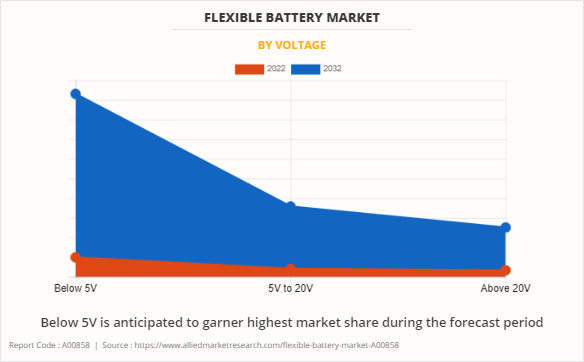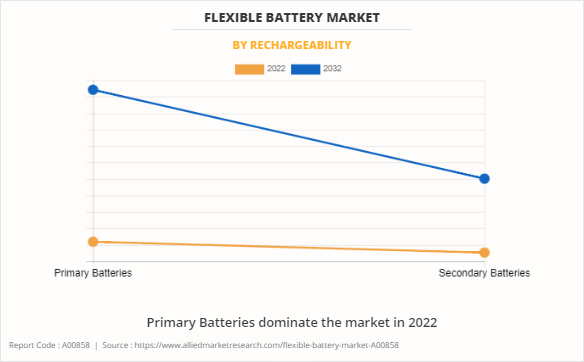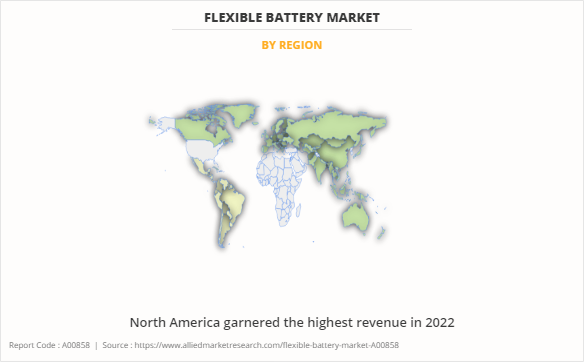Flexible Battery Market Research, 2032
Global Flexible Battery Market was valued at $0.17 billion in 2022 and is projected to reach $1.5 billion by 2032, growing at a CAGR of 24.9% from 2023 to 2032.
The expanding application of flexible batteries in consumer electronics is driving demand growth. These batteries offer versatility in design and enable innovative product development, meeting the evolving needs of consumers for compact, lightweight, and adaptable electronic devices.

A flexible battery is a type of battery, both primary and secondary, that is designed to be conformal and flexible, unlike traditional rigid batteries. It maintains its characteristic shape even when continuously bent or twisted, making it suitable for use in flexible and wearable electronics. The design of flexible batteries allows them to be folded, twisted, and stretched, and they can be fabricated into different shapes and sizes using various methods, such as using polymer binders to fabricate composite electrodes or printing the electrode materials onto flexible substrates. These batteries are particularly well-suited for portable and flexible electronics due to their conformability, light weight, and portability.
Key Takeaways of Flexible Battery Market Report
- On the basis of type, the Thin-film Batteries segment dominated the flexible battery market size in terms of revenue in 2022 and is anticipated to grow at the fastest CAGR during the forecast period.
- On the basis of voltage, the below 5V segment dominate the flexible battery market share in terms of revenue in 2022, owing to its compatibility with a wide range of consumer electronics.
- On the basis of rechargeability, the Primary battery segment dominate the flexible battery market, owing to its convenience and simplicity, offering disposable power solutions suitable for applications where recharging is infrequent or impractical.
- On the basis of application, the consumer electronics segment dominated the flexible battery market share in terms of revenue in 2022, owing to increasing demand for portable electronic devices such as smartphones, wearables, and IoT gadgets requiring compact and lightweight power solutions and is anticipated to grow at the fastest CAGR during the forecast period.
- Region wise, North America region dominated the flexible battery market in terms of revenue in 2022. Specially US dominate the flexible battery market size by country in North America region. While, the market in Asia-Pacific is anticipated to grow at the highest CAGR during the forecast period.
Segment Overview
The flexible battery market is segmented into type, voltage, rechargeability, application, and region.
By Type
Thin-film Batteries accounts for largest share in 2022
On the basis of type, the market is divided into Thin-film Batteries, and Printed Batteries. In 2022, the thin-film batteries segment was the highest revenue contributor to the market in 2022., owing to to its superior energy density, flexibility, and scalability, making it well-suited for various applications such as wearables, medical devices, and IoT sensors.

On the basis of voltage, the market is bifurcated into below 5V, 5V to 20V, and above 20V. In 2022, below 5V segment acquired the largest share and is expected to grow at a significant CAGR from 2023 to 2032, owing to increasing demand for portable gadgets and advancements in technology enhancing the efficiency and versatility of low-voltage devices.

On the basis of rechargeability, the market is segmented into primary batteries, and secondary batteries. In 2022, the primary battery segment will dominate the market in terms of revenue, owing to its widespread use in disposable electronic devices and applications where long-term reliability and maintenance-free operation.
By Application
Consumer Electronics is projected as one of the most lucrative segment
On the basis of application, the market is classified into consumer electronics, smart packaging, smart cards, medical devices, wireless sensors, and others. The consumer electronics segment was the highest revenue contributor to the market in 2022.

On the basis of region, it is analyzed across North America (the U.S., Canada, and Mexico), Europe (the UK, Germany, France, Italy, and the rest of Europe), Asia-Pacific (China, Japan, India, South Korea, and the rest of Asia-Pacific), Latin America (Brazil, Argentina, and the rest of Latin America), and the Middle East and Africa (UAE, Saudi Arabia, Qatar, South Africa, and the rest of the Middle East and Africa). The Asia-Pacific flexi charge batteries market is expected to grow at the highest CAGR during the forecast period.
Flexible batteries offer a multitude of advantages stemming from their adaptable and bendable nature. Their primary benefit lies in their ability to seamlessly integrate into unconventional and compact designs, powering various electronic devices without imposing rigid structural constraints. This flexibility enables the creation of innovative and ergonomic products, particularly in the realm of wearable technology and flexible displays.
In addition, the lightweight and thin profile of these batteries contributes to reduced overall device weight, enhancing user comfort. The malleability of flexible batteries also facilitates easier manufacturing processes, allowing for cost-effective production and potential customization of shapes to fit specific applications.
Furthermore, bendable battery resistance to mechanical stress and the ability to withstand bending cycles ensure durability, making them ideal for applications where traditional rigid batteries might face challenges. As a result, the widespread adoption of flexible batteries continues to drive advancements in portable and shape-conforming electronic devices.
Competitive Analysis
Competitive analysis and profiles of the major flexible battery companies, such as Samsung SDI Co., Ltd., LG Chem, Panasonic Corporation, Apple, Inc., Blue Spark Technologies, Inc., Ultralife Corporation., Imprint Energy, Molex, STMicroelectronics N.V., ProLogium Technology Co., Ltd., are provided in this report. Product launch and acquisition business strategies were adopted by the major market players in 2022.
Market Dynamics
The surge in usage of the Internet of Things (IoT) and the widespread deployment of interconnected devices
The surge in usage of the Internet of Things (IoT) and the widespread deployment of interconnected devices foster the demand for flexible batteries. With the expansion of IoT, a variety of devices with different shapes and functionalities emerge, requiring power solutions that adapt to unconventional designs. Flexible batteries, known for their ability to conform to different shapes and sizes, address the evolving needs of IoT applications. This adaptability not only facilitates the seamless integration of batteries into compact IoT devices but also ensures optimal performance. It paves the way for a new era of interconnected technologies applicable across industries, ranging from smart homes to healthcare and other industries.
The increase in focus on making technologically advanced batteries
The increase in focus on making technologically advanced batteries smaller and lighter is a key factor propelling the demand for flexible batteries. As electronic devices continue to shrink in size and weight, traditional rigid batteries become impractical. Flexible batteries, with their pliable and adaptable nature, perfectly align with the trend toward compact and lightweight designs. For instance, in 2022, the consumer electronics market generated a total revenue of $987 billion. Flexible batteries can conform to various shapes and allow seamless integration into smaller and unconventional spaces, enabling manufacturers to meet the demand for sleek, portable gadgets without compromising on power. This adaptability enables manufacturers to meet the growing demand for sleek and portable gadgets, emphasizing the crucial role flexible batteries play in powering the next wave of lightweight and highly portable electronic devices.
Limited energy density
Limited energy density hinders the growth of the bending battery market due to its impact on the amount of energy stored per unit volume or weight. While flexible batteries excel in adaptability, some variants fall short in energy density compared to rigid counterparts. This limitation hinders their ability to provide sufficient power for certain applications, influencing their competitiveness in the market. This limitation restricts their capacity to store and deliver power, which affects their suitability for certain high-power applications or devices with long battery life requirements. Advancements in materials and design are necessary to boost energy density, ensuring that flexible batteries effectively fulfill the varied energy storage demands across industries.
The rapidly expanding market for wearable technology
The rapidly expanding market for wearable technology offers a significant opportunity for flexible battery manufacturers. The wearable technology market presents a significant opportunity for flexible batteries. With the rapid surge in demand for wearables, including smartwatches, fitness trackers, and healthcare devices, there is an increase in the need for power sources that seamlessly integrate into the compact and unconventional designs of these devices. Flexible batteries, with their pliable and adaptable characteristics, perfectly align with the requirements of wearable technology. Their ability to conform to various shapes and sizes enables efficient utilization of available space within wearables, facilitating enhanced user comfort and overall design flexibility. With the continuous expansion of the wearable technology market, flexible batteries are poised to play a crucial role in powering these innovative and often shape-conforming devices, presenting a compelling solution for both manufacturers and consumers.
Country Analysis
In North America, the U.S. holds the largest share of the flexible battery market in the North America region, and the U.S. flexible battery market overview is expected to grow at a CAGR of 25.12% during the forecast period of 2023–2032 due to the increasing demand for wearable electronics, advancements in flexible battery technologies.
In Europe, the rest of Europe dominated the Europe flexible battery market share in terms of revenue in 2022 and is expected to follow the same trend during the forecast period. Moreover, Germany is expected to emerge as one of the fastest-growing countries in Europe in the flexible battery industry, with a CAGR of 26.12%, owing to a strong focus on technological innovation, robust R&D initiatives, and a growing market for wearable electronics and flexible devices.
In Asia-Pacific, China holds the dominant Flexible Battery Market Size by Country, and similar trends are expected to follow during the forecast period, due to technological advancements and a significant demand for flexible batteries, especially in consumer electronics. Furthermore, China is expected to emerge with the highest CAGR in the Asia-Pacific region in the flexible battery market in this region.
In Latin America, the rest of Latin America region accounted for the largest market share of the rest of Latin America and is expected to follow the same trend over the forecast period, as its economy grows, liquidity uses up, and smart cities continue to expand. However, Argentina is expected to emerge as one of the fastest-growing countries in Latin America in the bendable battery industry, with a CAGR of 22.07%, owing to its strategic geographic location, advanced logistics infrastructure, and growing emphasis on technology adoption.
In the Middle East and Africa, the UAE dominated the flexible battery market growth and is expected to follow the same trend during the forecast period, due to advanced logistics infrastructure, strategic positioning, and technological leadership.
Recent Developments in Flexible Battery Industry
In March 2023, STMicroelectronics, a semiconductor company, made lithium batteries to perform well and last longer with a high-accuracy BMS (Battery Management System) controller. STMicroelectronics’ L9961 BMS device delivers accuracy and flexibility to improve the performance, lifetime, and safety of Li-ion as well as Li-polymer batteries.
Key Benefits For Stakeholders
- This report provides a quantitative analysis of the market segments, current trends, estimations, and dynamics of the flexible battery market analysis from 2022 to 2032 to identify the prevailing flexible battery market opportunity.
- The market research is offered along with information related to key drivers, restraints, and opportunities and also flexible battery market share by company.
- Porter's five forces analysis highlights the potency of buyers and suppliers to enable stakeholders make profit-oriented business decisions and strengthen their supplier-buyer network.
- In-depth analysis of the flexible battery market segmentation assists to determine the prevailing market opportunities.
- Major countries in each region are mapped according to their revenue contribution to the global market.
- Market player positioning facilitates benchmarking and provides a clear understanding of the present position of the wearable flexible battery market players.
- The flexible battery market report includes the analysis of regional as well as global flexible battery market trends, key players, market segments, application areas, and flexible battery growth projections strategies.
Flexible Battery Market Report Highlights
| Aspects | Details |
| Market Size By 2032 | USD 1.5 billion |
| Growth Rate | CAGR of 24.9% |
| Forecast period | 2022 - 2032 |
| Report Pages | 249 |
| By Type |
|
| By Voltage |
|
| By Rechargeability |
|
| By Application |
|
| By Region |
|
| Key Market Players | LG Chem, Blue Spark Technologies, Inc., Apple, Inc., Ultralife Corporation., ProLogium Technology Co., Ltd., Imprint Energy, Molex, Panasonic Corporation, STMicroelectronics N.V., Samsung SDI Co., Ltd. |
Analyst Review
The utilization of flexible batteries has increased in energy storage, fueled by the increasing demand for wearable technologies. CXOs should monitor advancements in materials and manufacturing to stay side by side of developments impacting efficiency, durability, and cost-effectiveness. Managing initial production costs poses a significant challenge amidst this innovation. Strategic decision-making becomes paramount, balancing cutting-edge investments with economic viability.
The surge in interest in the Internet of Things (IoT) presents a significant opportunity for seamless integration of flexible batteries into the expanding ecosystem of connected devices. Executives must embrace a forward-thinking approach, adopting flexibility not just in battery design but also in strategic decisions to capitalize on the market's immense potential. Proactive leadership is key to positioning organizations at the forefront of this transformative wave in energy storage.
The key players profiled in the report include Samsung SDI Co., Ltd., LG Chem, Panasonic Corporation, Apple, Inc., Blue Spark Technologies, Inc., Ultralife Corporation., Imprint Energy, Molex, STMicroelectronics N.V., ProLogium Technology Co., Ltd. These key players have adopted strategies such as product portfolio expansion, mergers & acquisitions, agreements, geographical expansion, and collaborations to enhance their market penetration.
The increasing demand for wearable devices, the growth of Internet of Things (IoT) Devices, and the development of foldable and rollable electronic devices, such as foldable smartphones and rollable displays are the upcoming trends of the flexible battery market in the world.
Consumer Electronics is the leading application of flexible battery market.
North America is the largest regional market for flexible battery.
In 2022, the estimated industry size of flexible battey is $170.71Million.
Samsung SDI Co., Ltd., LG Chem, Panasonic Corporation, Apple, Inc., Blue Spark Technologies, Inc., Ultralife Corporation., Imprint Energy, Molex, STMicroelectronics N.V., ProLogium Technology Co., Ltd are the top companies to hold the market share in flexible battery.
Loading Table Of Content...
Loading Research Methodology...


